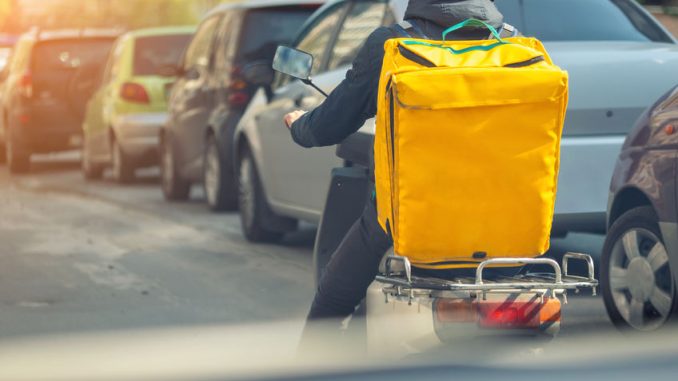
Bit of a corny title for an article but it was much better than some of the bland titles I’d come up with earlier. Ghost kitchens or dark kitchens as they also known as seem to be the way forward for many professional restauranteurs and chefs needing to earn a crust through the pandemic. Just to get this out of the way sooner, try saying ghost kitchens really fast and over and over and it becomes ‘ghost chickens’. Thought you ought to know!
You might ask what these ghost kitchens are. Essentially these are professional food preparation and cooking facilities designed for solely for delivery of takeaway food. You certainly cannot eat there or even collect your own meal from them but these places exist as a way of getting their food to our mouths.
The term ‘ghost kitchen’ seems preferable to others like ‘virtual kitchen’, ‘dark kitchen’ or ‘cloud kitchen’ although dark kitchen as something of the night about it. The ‘ghost’ adjective conveys a more otherworldly mystical element to them.
It may seem surprising. These kitchens how ever you name them have been around for years. I searched the sources for their brand names but actually couldn’t find any of note and that’s probably because they were local firms on the periphery of the food service offering. In the pandemic these facilities have taken on a special significance.
So what is a ghost kitchen? Essentially it’s a facility that has all the equipment and space required for preparing restaurant or cafe style meals but without a specific dining area or indeed a place for collection of food by the customer. So it’s not a true takeaway. What it does mean in perhaps more unique terms is this place for meal preparation that can be shipped off to various locations making full use of the available transport services that are also thriving. No-one who likes a good quality meal needs to miss out and this is a subtle difference.
Quite a few individuals have adopted the entrepreneurial spirit. They have set up their own unbranded ghost kitchens. As long as they meet food safety and hygiene laws there is no limit to what is possible. From a business perspective it is ideal as a start-up. No staff apart from a chef and may be someone to box up the meal, no other facilities such as a seating space and with it just marginal overheads. There are no capital costs other than the essentials for food preparation and someone to make that food.
What is essential though is some form of online presence. In fact there is no maybe as its critical to make sure the customer has a name or place to fix on and where to find it out there in cyberspace. In the USA where this concept has considerable traction there are no signs on the street for places like Monster Mac or Firebelly Wings. Thanks to France24.com, I’d never heard of them and neither would many others without somebody referencing them in their news articles.
You need to look on your smartphone for these names and how to contact them. All these brands are here primarily for delivery.
Lets see what the offering is. Looking at Monster Mac, we can see they cater for big-hearted Americans. The classics around macaroni cheese abound. So as well as Mac & Cheese, there are variants such as Street Mac and Truffle Mac. I assume these are not registered trademarks but they do have yummy sounding descriptions. Quite like the sound of ‘The Loaded Beast’. It also think the Mac Bites also have something going for them. They don’t appear to deliver to the Forest of Dean so I will have to take their product description and recreate it at home.
Consumer Behaviour In the Light Of The Pandemic And Ghost Kitchens
Consumer behaviour has markedly changed in the light of the pandemic. We are ordering from delivery platforms like never before and adopted ‘convenience’ almost above all else. It started this way because restaurants were closing down for months during lockdown. This might not and hopefully not be something permanent. If they did remain open or then reopened, social spacing rules meant that they operated with reduced capacity and numbers. The effect was such that customers of any type of dining found they preferred to eat at home and cook rather than risk becoming infected with COVID-19. In the light of all this a market suddenly revealed itself in the demand for delivery of the same type of food they were used to having when out and about on the town.
So, ghost kitchens which had existed before were now pushed into the limelight as the pandemic took hold. The leading food delivery platform in the USA which is DoorDash found they had and still have as far as we are aware, 47 per cent of market share. Last year between January and September they handled 543 million orders. That was a three-fold increase on last year. This business has found itself replacing through their delivery operation all those restaurants that had to close down.
There has also been a place for businesses that build and offer fully equipped kitchens just for others to create a dark kitchen. There are people like Kitchen United, CloudKitchens owned by Uber co-founder Travis Kalanick, Zuul and C3 who are providing the firepower for thoe dipping their toes into ghost kitchening. Most of these businesses also offer various levels of technical support so that the newly developed owners can manage orders and also provide much wanted marketing advice on developing their brands. One business Nextbite has concentrated on brand development to help with development of new menus for existing kitchens.
By the way, the traditional caterers are not missing out either. They are opening their own ghost kitchens using the power of their existing brand but also developing and inventing their own cuisine to fit as well as tailoring their original offering.
In the UK, Deliveroo have certainly upped their level of advertising. With the Deliveroo app, in 2021, this January, the UK population can now easily order their grub using this specific app. For Deliveroo, there is so much interest in their offering that they have expanded to the point where two thirds of the population can order a takeaway. That has risen as lockdown rules tighten.
In due course some form of branding is needed but for many that isn’t an option if costs on marketing are to be pared down. What does the consumer of these services expect. Well for a start, the food itself and the convenience of ordering that goes with it. It does mean that orders need to be taken, recorded and monitored so that the right food is available as when needed.
For many though the ghost kitchen represents their only lifeline. Whilst there are less jobs generally out there this is the way forward. It may be the case that when the virus is under control we all return to our previous way of eating out but customers may well have a liking for this type of service. It is not likely that customers will simply ditch this idea. If it offers convenience and with the same quality of food to boot then its more than possible we continue well into the foreseeable future.
References
Deliveroo moves to 100 more towns, doubles dark kitchens (Article).
Delivery-only ‘ghost’ kitchens’ fourish during pandemic (Article)

I feel this is an important development in food service. A well thought out item!